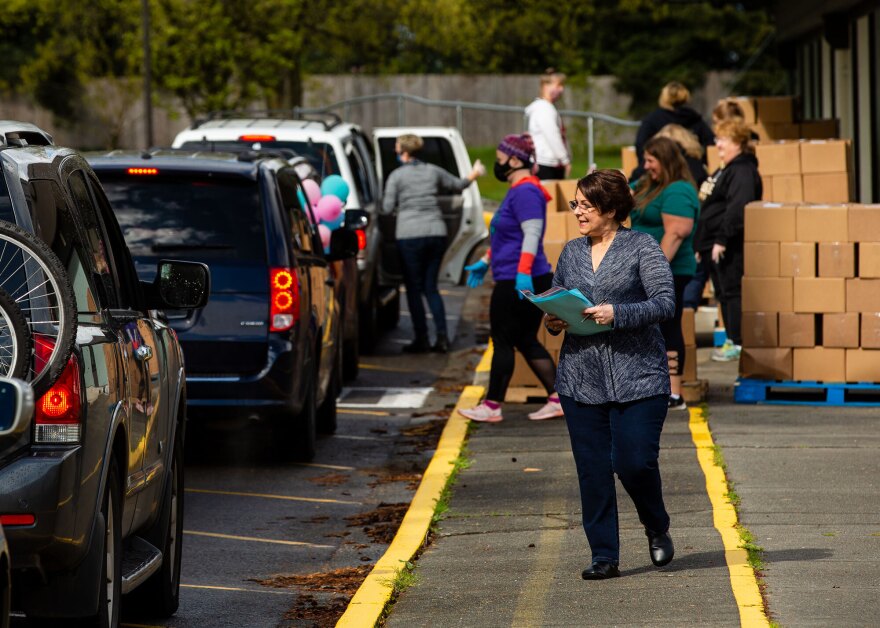Rosa showed up 40 minutes early to Kentridge High School in the Kent school district on Monday for the weekly school meal distribution. And she wasn’t even the first one in line.
Cars soon lined up behind her, snaking out onto Southeast 208th Street in front of the school — an eye-opening example of the importance of school meals as a lifeline for families right now.
Rosa was sure to get there early to pick up a box of breakfasts and lunches for each of her three children, ages 9, 6 and almost 3. Last week, she barely managed to get food before supply ran out. That was the second week in a row that the Kent school district ran out of meals.
“I don’t have much money to buy actual food, so the milk helps a lot — they go through it in less than a week,” she said. “It helps.”
Rosa is a stay-at-home mom. Her husband is unemployed right now because the landscaping business where he works had to shut down. She said she doesn’t blame the district for running out of food last week; it’s hard to know how much to prepare because demand keeps rising as more people lose their jobs.
“We don’t know if people are going back to work or not,” she said. “People are coming more for the food. Maybe they didn’t come before and they’re coming now. That’s what I think.”
The need is great, especially in Kent and other parts of South King County, home to large immigrant communities. About 53 percent of students in the Kent school district, which serves about 26,000 students, qualify for free or reduced-price meals.
The school district ramped up production this week, preparing an extra 1,800 boxes. This week it was enough — the district handed out meals for more than 6,000 children, compared with about 5,100 last week and 3,700 the week before that.

At Kentridge High School, kitchen manager Julie Armstrong kept track of the tally and greeted each driver.
“Good morning, how many today?” she said. Many families asked for two or three boxes, but some requested as many as eight. “You got it,” she’d tell them.
Other districts have shifted to once-a-week distribution. When Puyallup made the switch, the school district also ran out of food even though it prepared twice as many meals as it distributed the week before. The next week, the district doubled production again, to 7,000 boxes of meals, and that was enough to meet demand. Federal Way Public Schools made the switch this week, preparing an extra 1,000 boxes, but that also wasn’t enough. A district spokeswoman said they’re improving processes for next week.
At Kentridge High School, volunteers loaded boxes of food directly into people’s cars. The boxes contain cereal, bagels, fruit, milk, juice and some items that can be heated, such as grilled cheese sandwiches.

Parent volunteer Melissa Anderson was pleased to see that the site had enough supply this week. She was there last week when they ran out and had to turn away about three dozen cars.
“It’s frustrating for anybody involved,” she said. “It’s frustrating for the district. It’s frustrating for the nutritional people who don’t have the resources to make it work. And it’s frustrating for the parents who wait in line to feed their kids.”
And some parents showed up to load their cars with meals for other families that can’t get to the site. Megan Carter, president of the PTSA for Emerald Park Elementary, picked up 13 boxes to deliver to four families. She gets emotional when she talks about why she’s been helping out in this way.
“I’m just worried for the kids. I just want them to have full bellies and I just want to make sure they’re OK, and I think it’s such a basic need,” Carter said. “My kids are fine, and I want to make sure all the kids in our schools are fine.”
Carter said she's hoping the Kent school district will open more food distribution sites. She's been working with district leaders to try to make that happen.







